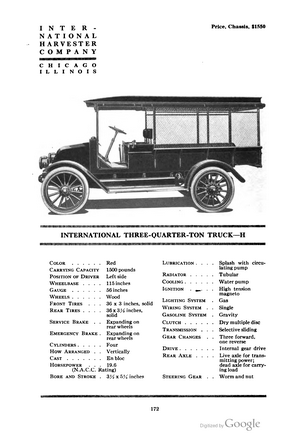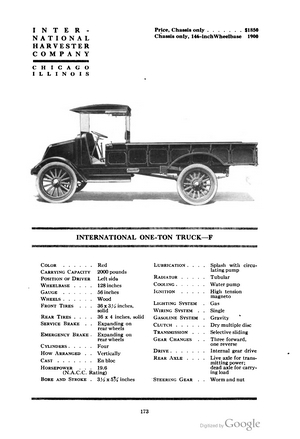















International Harvester |
|---|
|
| Topic Navigation |
|---|
|
Wikipedia: International Harvester
Subtopics International Trail Page Sections History Images Documents Article Index |
History
The following section is an excerpt from Wikipedia's International Harvester page on 26 November 2017, text available via the Creative Commons Attribution-ShareAlike 3.0 Unported License.
The International Harvester Company (abbreviated first IHC and later IH) (now known as Navistar International Corporation) was a United States manufacturer of agricultural machinery, construction equipment, trucks, and household and commercial products. In 1902, J.P. Morgan merged the McCormick Harvesting Machine Company and Deering Harvester Company, along with three smaller agricultural equipment firms, to form International Harvester. In 1985, International Harvester sold off most of its agricultural division to Tenneco, Inc., which merged it into its subsidiary J.I. Case under the Case IH brand. Following the terms of IH's agreement with Tenneco, International Harvester renamed itself Navistar International Corporation in 1986.
The roots of International Harvester run to the 1830s, when Cyrus Hall McCormick, an inventor from Virginia, finalized his version of a horse-drawn reaper, which he field-demonstrated throughout 1831, and for which he received a patent in 1834. Together with his brother Leander J. McCormick (1819–1900), McCormick moved to Chicago in 1847 and started the McCormick Harvesting Machine Company. The McCormick reaper sold well, partially as a result of savvy and innovative business practices. Their products came onto the market just as the development of railroads offered wide distribution to distant market areas. He developed marketing and sales techniques, developing a vast network of trained salesmen able to demonstrate operation of the machines in the field.
McCormick died in 1885, with his company passing to his son, Cyrus McCormick, Jr., whose antipathy and incompetence toward organized labor sparked the Haymarket affair, the origin of May Day as a labor holiday. In 1902, the McCormick Harvesting Machine Company and Deering Harvester Company, along with three smaller agricultural equipment firms (Milwaukee Harvesting Machine Co., Plano Manufacturing Co., and Warder, Bushnell, and Glessner—manufacturers of Champion brand) merged to create the International Harvester Company. Banker J.P. Morgan provided the financing. In 1919, the Parlin and Orendorff factory in Canton, Illinois, was a leader in the plow manufacturing industry. International Harvester purchased the factory, calling it the Canton Works; it continued production for many decades.
Light duty trucks
IH is often remembered as a maker of relatively successful and innovative "light" lines of vehicles, competing directly against the Big Three. The most common were Pickup trucks. IH made light trucks from 1907 to 1975, beginning with the Model A Auto Wagon (sometimes called the "Auto Buggy"). Production commenced in February 1907 at IH's McCormick Works in Chicago, although production was moved to Akron, Ohio, in October that year. Powered by a horizontally opposed, air-cooled twin around 15 hp (11 kW), it was a right-hand-drive model popular in rural areas for high ground clearance on the poor roads typical of the era. It featured a rear seat convertible to a carrier bed. The Auto Wagon was renamed the Motor Truck in 1910, and was a forerunner to the successful modern pickup truck. They were called IHC until 1914, when the 'International' name was first applied. The final light line truck was made on May 5, 1975.
IH also had early success with the Auto Buggy, which started production in February 1907. In the mid-1940s, International released their K and KB series trucks, which were more simplistic than other trucks released in that era. This was followed by the L Series in 1949, which was replaced by the R Series in 1952, followed by the S line in 1955. In 1957, to celebrate IH's golden anniversary as a truck manufacturer, this was replaced by the new A line. 'A' stands for anniversary. With light modifications to its appearance but more serious changes under the shell (and a number of new names), this design continued in production until replaced by the 1100D in late 1969, which looked very similar to the Scout.
Corresponding with the truck "letter lines" was the Metro line of step (delivery) vans. Starting in 1938 and manufactured through 1975, the Metro series was produced and updated with each iteration of IH's truck lines. Also, special-use variants were sold, such as the Metro Coach (a bus version with windows and passenger seats) and Metro front-end section and chassis for full commercial customization. Additional variants were based on the medium-duty engine and chassis lines.
One of the company's light-duty vehicles was the Travelall, which was similar in concept to the Chevrolet Suburban. The Travelette was a crew cab, available in two or four-wheel drive. A three-door version was available starting in 1957, and a four-door version was available starting in 1961. The 1961 Travelette four-door (crewcab) was the first six-passenger, four-door truck of its time. The Scout, first introduced in 1961, is a small, two-door SUV, similar to a Jeep. In 1972, the Scout became the Scout II, and in 1974 Dana 44 axles, power steering, and power disc brakes became standard. After the Light Line pickups and Travelall were discontinued in 1975, the Scout Traveler and Terra became available, both with a longer wheelbase than a standard Scout II.
IH abandoned sales of passenger vehicles in 1980 to concentrate on commercial trucks and school buses. Today, the pickups, Travelalls, and Scouts are minor cult orphaned vehicles. All were also available as rugged four-wheel drive off-road vehicles.
The Scout and Light Truck parts business was sold to Scout/Light Line Distributors, Inc. in 1991.
Medium/heavy duty
IH was an early manufacturer of medium- and heavy-duty trucks. Although based upon truck chassis, IH also became the leading manufacturer of the chassis portion of body-on-chassis conventional (type C) school buses. In 1962, IH offered the International Harvester Loadstar which became the premier medium-duty truck. In 1978, IH offered the International Harvester S-Series, which replaced the Loadstar in 1979.
With the truck and engine divisions remaining following the 1985 sale of the agricultural division, International Harvester Company changed their corporate name to Navistar International in 1986. Today, Navistar International's subsidiary, International Truck and Engine Corporation, manufactures and markets trucks and engines under the International brand name.
The Ford Power Stroke engine was manufactured by International Truck and Engine Corporation in Indianapolis, Ind., for use in Ford heavy-duty trucks, vans, and SUVs.
Military
IH manufactured light, medium, and heavy vehicles for military use. Examples include a Metro van sold to the Czechoslovakian Army in 1938, as M5 Tractors and 2.5-ton M-5H-6 trucks for the US Navy and Marines in 1942, and around 3,500 2.5 ton M-5-6-318 cargo trucks provided mostly to Soviet Union and China.
Motorhomes
In the 1970s, motorhomes were manufactured using IHC engines and bare chassis. Most of the bodies were constructed of fiberglass.
 |
International Three-Quarter-Ton Truck (H) Hand Book of Automobiles, 1919 Edition View International Three-Quarter-Ton Truck (H) page of Hand Book of Automobiles, 1919 Edition - 643KB |
 |
International One-Ton Truck (F) Hand Book of Automobiles, 1919 Edition View International One-Ton Truck (F) page of Hand Book of Automobiles, 1919 Edition - 430KB |
| Date | Document Name & Details | Documents |
|---|---|---|
| 1956 | International Harvester Credit Corp. v. Goodrich 350 U.S. 537 (1956) Decision Supreme Court of the United States | Text - 1 page |
| 1966 | International Trail International Harvester | JPG - 60.4MB - 24 pages |
| 31 October 1966 | NHTSA Recall 66V019000 International Harvester STEERING:LINKAGES:LINK:DRAG:CONNECTION National Highway Traffic Safety Administration | Recall Page - 1 page |
| 25 November 1966 | NHTSA Recall 66V025000 International Harvester STEERING:LINKAGES:LINK:DRAG:CONNECTION National Highway Traffic Safety Administration | Recall Page - 1 page |
| 1969 | International Trail International Harvester | JPG - 59.4MB - 24 pages |
| Date | Article | Author/Source |
|---|---|---|
| 26 December 2013 | The 1961 International Harvester Travelette  | Bill Crittenden |
